#Glasgow Museums Resource Centre
Text
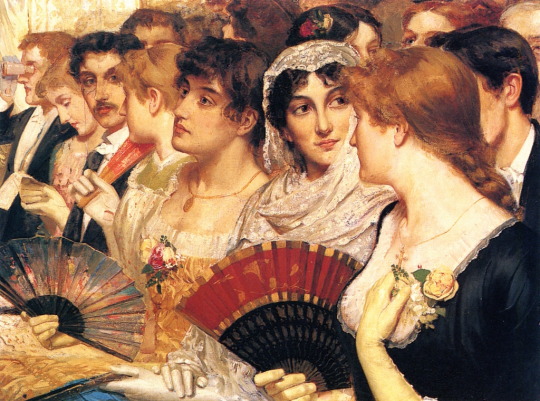
In the Front Row at the Opera (aka The Overture), William Holyoake, ca. 1880
Happy World Opera Day!
#art#art history#William Holyoake#genre painting#genre art#opera#World Opera Day#British art#English art#19th century art#Victorian period#Victorian art#oil on canvas#Glasgow Museums Resource Centre
594 notes
·
View notes
Text
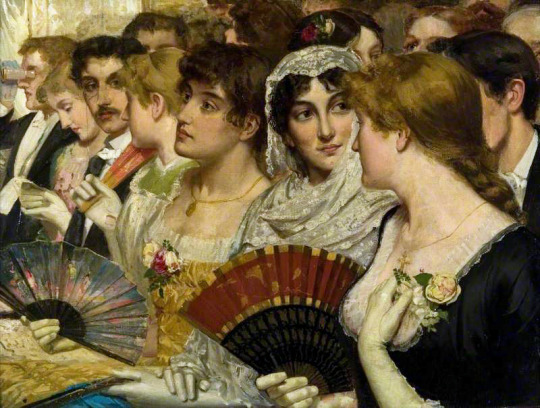
In the Front Row at the Opera
William Holyoake (1834–1894)
Glasgow Museums Resource Centre (GMRC)
492 notes
·
View notes
Text
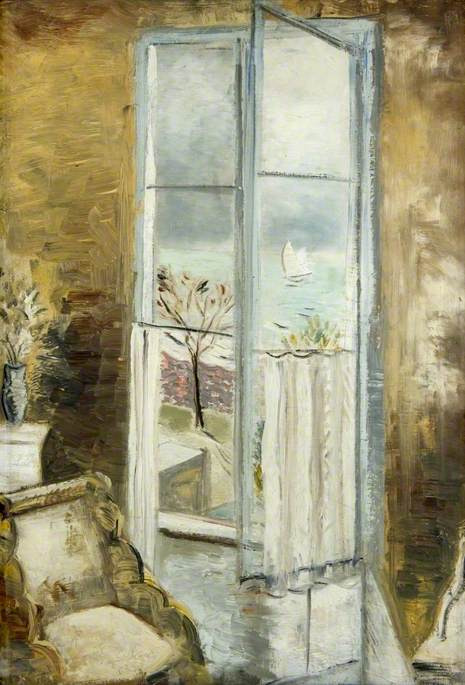
Paul Nash (British, 1889-1946) • Through a Window, Riviera • 1927 • Glasgow Museums Resource Centre, Glasgow, Scotland
Paul Nash was a British surrealist painter and war artist, as well as a photographer, writer and designer of applied art.
#art#fine art#painting#british artist#paul nash#the painted room blog#art blog#paintings of interiors#paintings of domestic interiors#art history#art appreciation#war artist#oil painting#artwork#art enthusiast#obscure artists
70 notes
·
View notes
Text

James Cowey (British/Scottish, 1886 - 1956) • The Looking Glass • c. 1940–1950 • Glasgow Museums Resource Centre (GMRC), Scotland
#still life#art#painting#fine art#art history#james cowie#british/scottish artist#oil painting#art of the still life art blog#artwork#20th century british art#1940s artwork#art blogs on tumblr#art lovers on tumblr
30 notes
·
View notes
Text
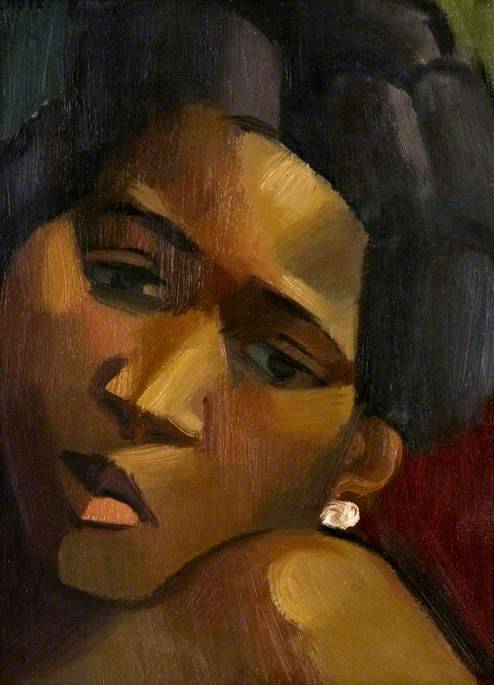
André Lhote (french, 1885–1962)
Head of a Woman
Glasgow Museums Resource Centre (GMRC)
21 notes
·
View notes
Text

1908 Lady Newlands by Hugh Goldwin Riviere (Glasgow Museums Resource Centre - Glasgow, Lanarkshire, UK). From artrenewal.org 2002X2556.
#1908 fashion#1900s fashion#Edwardian fashion#Belle Époque fashion#Lady Newlands#Hugh Goldwin Riviere#pompadour coiffure#bun#poter pigeon bodice#clerical neckline#elbow-length outer sleeves#long inner sleeves#close skirt
12 notes
·
View notes
Photo
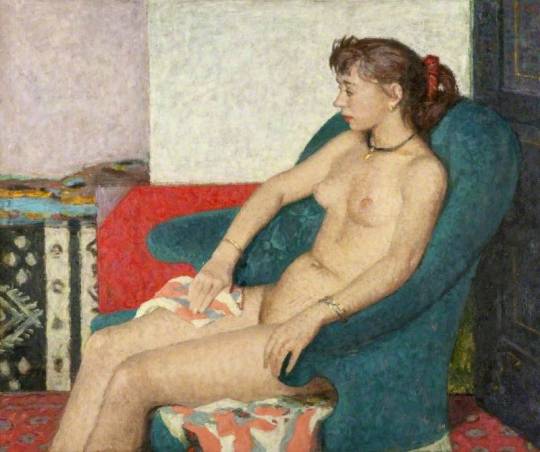
Model Resting
Edward Le Bas (1904–1966)
Glasgow Museums Resource Centre (GMRC)
71 notes
·
View notes
Photo
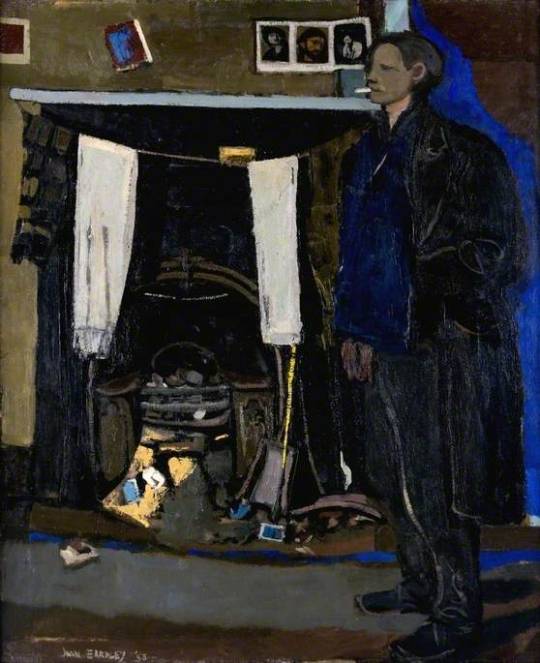
Joan Eardley 1921 - 1963
A Glasgow Lodging
1953
Oil on canvas
H 112.9 x W 92.8 cm
Glasgow Museums Resource Centre
© the Eardley estate. All rights reserved, DACS 2022. Photo credit: Glasgow Life Museums
13 notes
·
View notes
Text
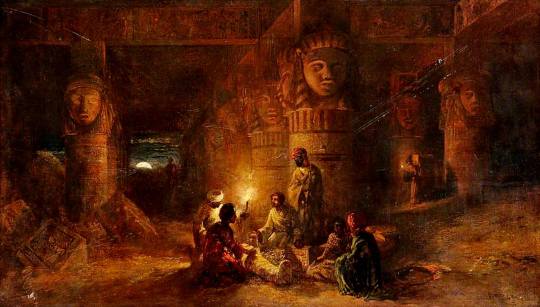
مكتشفي الكنوز في معبد دندره 1843
للفنان البريطاني ويليام جيمس مولر
The Treasure Finders , Temple of Denderah 1843
By William James Müller - British , 1812–1845
Oil on canvas, 74.9 x 135.9 cm
Glasgow Museums Resource Centre - GMRC
0 notes
Text
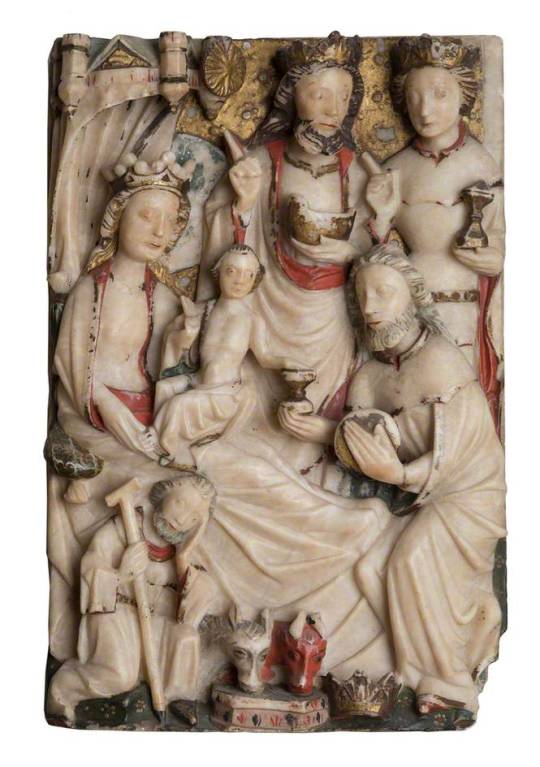
The Adoration of the Magi [15th C.]
unknown artist
Glasgow Museums Resource Centre (GMRC)
117 notes
·
View notes
Text
Art Studio 1 Lecture and 24th Biennale Gallery visit (Chau Chak Wing Museum) (22.3.24)
Lecture: Artist-run Spaces (by Alex Gawronski)
Artist-run Spaces (or ARIs - Artist-run Initiatives) are:
Spaces directed and organised by artists (collectives, studios, shows/exhibitions, festivals, workshops, etc.).
Dedicated to showcasing experimental contemporary art.
Usually running on a 'not-for-profit' basis (although art may occasionally be sold).
An international phenomenon (found everywhere)
Below are some examples (Australia):
Firstdraft (Sydney, Australia)
107 Projects (Sydney, Australia)
Airspace Projects (Sydney, Australia)
Gertrude (Melbourne, Australia)
Blindside (Melbourne, Australia)
Outer Space (Brisbane, Australia)
Sawtooth ARI (Launceston, Australia)
FeltSpace (Adelaide, Australia)
Watch This Space Gallery (Alice Springs, Australia)
Below are some examples (international):
Studio 1.1. (London, England) and its other galleries: Studio 1.2. (Haarlem, Netherlands), Studio 1.3. (Poços de Caldas, Brazil) and Studio 1.4. (Susak, Croatia)
PrintSpace (Brooklyn, US)
Transmission Gallery (Glasgow, Scotland)
VideoArt Center Tokyo (Tokyo, Japan)
EST Art Foundation (Leiden, Netherlands)
M1 Singapore Fringe Festival (Singapore)
OpenArt (Örebro, Sweden)
SPAO Photographic Arts Centre (Ottawa, Canada)
Mothermother (Auckland, New Zealand)
Artist-run Spaces run on different models in funding and exhibitions.
Funding:
Government funded (ie. The Australia Council etc. Other State funding bodies).
Self-funding as a co-op (members of the directorship pool their own financial resources to pay for gallery rent and exhibition costs).
Exhibitor funded (gallery is paid for on a not-for-profit basis, by a rental fee paid by exhibiting artists.
Auctions and Fundraisers organized by ARI directors.
A combination of the above.
Exhibition models:
Typically Government funded Als must, as a part of their agreement, accept outside proposals. That means the gallery directorship collectively decide which proposals they want to exhibit.
Self-funded co-ops can choose to accept proposals, but the onus will be determined by the co-operative.
Exhibitor-funded ARI models may accept proposals or may curate 'in-house' (ie. The directorship) actively curate the exhibition program without accepting proposals. Some of these are 'spaces for hire. That means they accept outside proposals for the primary purpose of covering the venue rent. They are often expensive and have less credibility within the art world (ALTHOUGH if you can afford it, they can be useful places to experiment if you're starting out).
There are many benefits to founding, directing or being involved in an Artist-run Space - including but not limited to:
Greater creative freedom in both the works you like to exhibit and the artists you'd like to work with
Greater freedom from limitations within institutional/commercial galleries
While another means of income may be needed, you don't have to deal with the pressure of selling your work
Collaboration opportunities, which can help you to form personal and professional connections
Gallery visit: 24th Biennale (Chau Chak Wing)
Citra Sasmita's Timur Merah Project X: Bedtime Story (2023, acrylic on traditional Kamasan canvas and oak dowels) and Timur Merah Project IV: Tales of Nowhere (2020, acrylic on traditional Kamasan canvas and oak dowels)


Description: "Citra Sasmita began researching patriarchal roots of modern Bali by looking to the literary and artistic canon of Indonesia, which broadly narrates male heroism and depicts women as romantic decorations. Through her Timur Merah Project, Sasmita creates counter-narratives that depict women as powerful and resistant actors who push back against a male gaze informed by colonial ideology.
Following the fall of the last Balinese kingdom in 1908, the Dutch administration introduced the policy of Baliseering. A strategy of cultural diplomacy intended to establish an 'authentic' Bali, the policy obliged the Balinese community to carry out their cultural practices under Dutch supervision. Javanese nationalists argued that the policy kept Bali as a living museum' that appealed to colonial aesthetics of the noble and exotic while obliterating any Balinese self-determination.
Balinese women, who for centuries were trafficked by the Dutch as particularly beautiful slaves, were often depicted in naturalistic portraits by colonial painters. In Timur Merah Project X: Bedtime Story and Timur Merah Project IV: Tales of Nowhere, Sasmita uses traditional Kamasan painting to reclaim the female figure as an active de-colonial agent challenging the exotic aesthetic heritage of Baliseering."
Cho Ka Fai's Exodus (2024, short film (18 mins 52 secs))
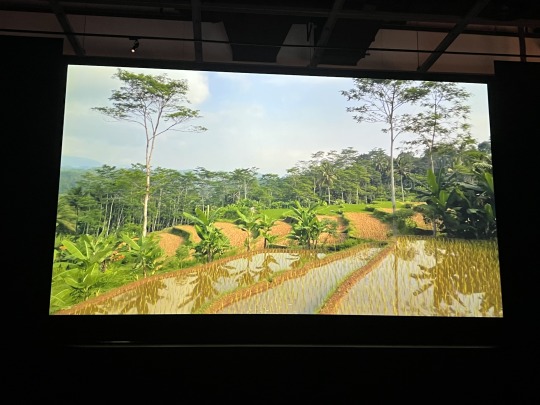

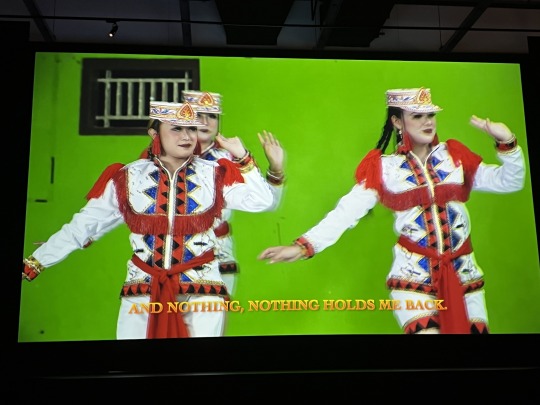


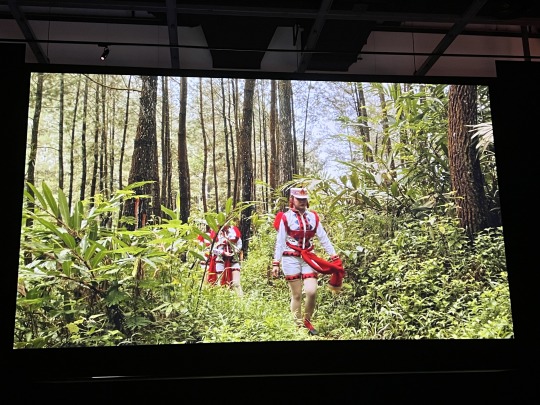
Description: "Gathered around the campfire one hot Javanese night in the 1930s, a contingent of Dutch soldiers drunkenly sang and danced while a group of Indonesian farmers watched from afar, mimicking the men's strange, rhythmic movements.
And so, Dolalak was born.
Something of a cultural constellation, Dolalak performers cosplay in Dutch military regalia for trance-like performances of traditional Javanese dance, melodic Islamic poems and songs of ancestral spirits. Popular among young Indonesian TikTok influencers who dance Dolalak to the tunes of Indonesian pop music (Dangdut Koplo), the ritual sits within a deeply layered history.
The same rich source resulted in an Indonesian band being hailed as the greatest live act in mid-century Europe some 20 years after the
development of Dolalak. Following the Dutch failure to re-invade Indonesia after the Second World War, a number of Dutch-speaking
Indonesian musicians, primarily from the Maluku Islands, were exiled to the Netherlands. In the same way that Dolalak rose from a colonial clash of cultures, Indo-Rock emerged in the 1950s/1960s when these musicians began to meld Western, Indonesian and Kroncong music, a specific genre in Indonesia played on Portuguese-introduced instruments. This fusion gave rise to leading bands like the Tielman Brothers, who reached stardom as icons of Dutch and West German rock 'n' roll.
In Exodus, the Dewi Arum Girls (TikTok stars) dance Dolalak to a remix of the Tielman Brothers, meditating on the colonial resonances that linger.
They dance like spirits, in the reverberations of Dolalak, Indo-Rock and contemporary digital culture."
Diane Burns' Alphabet City Serenade (1988, short film (1 min 57 secs))


Description: "Chemehuevi and Anishinaabe poet Diane Burns walks the streets of New York's Lower East Side (Loisaida colloquially) reciting her poem Alphabet City Serenade in this powerful footage.
An indictment of the gentrification of Loisaida and the treatment of First Nations Americans, Alphabet City Serenade paints the cracked windows and littered streets of Loisaida with a vivid and loving brush. The serenade also threads Burns into the fabric of the cityscape, with its crumbling tenements and narrow stretches of blue sky.
A prolific personality and artist, Burns read her work at Bowery Poetry Club, the Nuyorican Poets Cafe, and the Poetry Project at St. Mark's Church as well as joining the likes of writers Allen Ginsberg, Joy Harjo, and Pedro Pietri in Nicaragua for the Ruben Dario Poetry Festival.
Yet by the late 1980s, Loisaida, a counter-culture hub for creative, immigrant, and queer circles, was at risk of losing itself to rising rents, drugs, and the HIV epidemic. Before long, the community which had sustained Burns would dissipate, coming together again in 2006 on the event of her death. Over a career defined by an immutable spirit, Alphabet City Serenade captures the writer's sardonic, yet penetrating, insight..."
Mangala Bai Maravi's Baiga Godna Indian Tribe (2024, ink on paper)
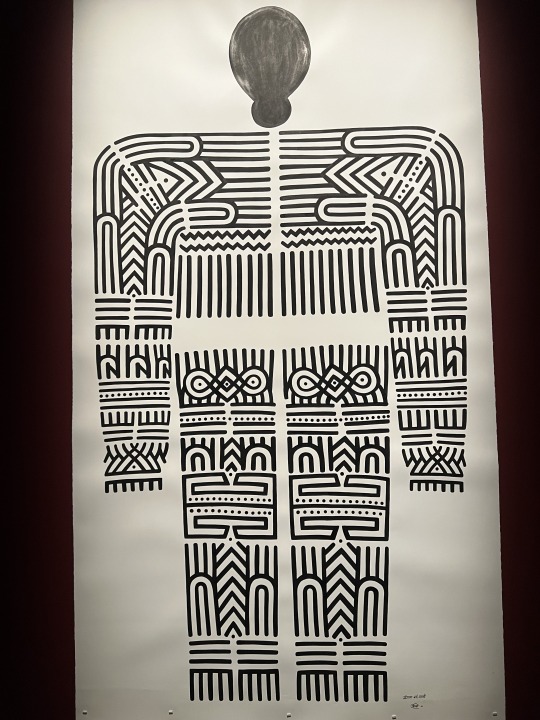
Description: "The women of the Baiga community in central
India (primarily in the state of Madhya Pradesh) begin receiving tattoos from as young as age nine, starting with their forehead before covering their back, legs and chest. The designs, known as Godna, are a record of life and culture, and are known to hold healing properties when applied correctly.
Among some of the earliest communities in South Asia, in recent times the Baiga people have been displaced by deforestation and government policy.
In turn, the tradition of Godna is fading because (unlike jewellery or written records) the history that is encapsulated in these tattoos disappears with those who wear them.
Mangala Bai Maravi, one of the few remaining Badnin (women tattoo artists) in her community, has committed her life to preserving and sharing this tradition. Documenting the symbols and stories of her people, across not only bodies but also canvas and paper, Maravi's practice can be understood as an act of cultural preservation and healing."
0 notes
Text
MUSEO IRREVERENTES: “Psychedelic Attack of the Blue Rabbits” (1990)
Oleg Holosiy (1965-1993)Óleo sobre lienzo200 cm x 300 cmGlasgow Museums Resource Centre (GMRC) (Glasgow, Reino unido)

View On WordPress
0 notes
Text
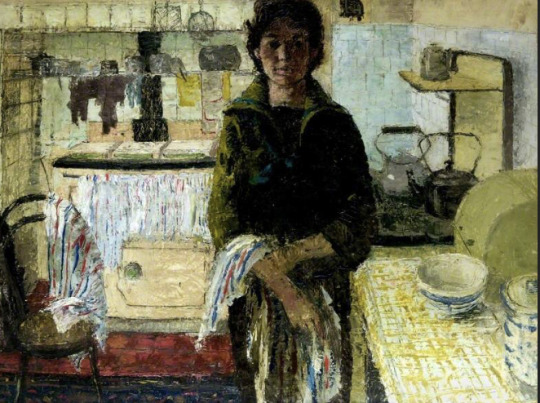
Self Portrait
Jean Fleming (1937–1988)
Glasgow Museums Resource Centre (GMRC)
0 notes
Text
Revealed Religion : Benjamin West. 059 of 100 Bible images
059 The Raising of Lazarus
The Raising of Lazarus. 1788. Oil on canvas. Height: 73.4 cms (28.9 ins), width: 116.8 cms (45.98 ins). Glasgow Museums Resource Centre.

View On WordPress
#American art#Benjamin West#Bible#Glasgow art#Lazarus#Phillip Medhurst#raising of Lazarus#Revealed Religion
1 note
·
View note
Photo
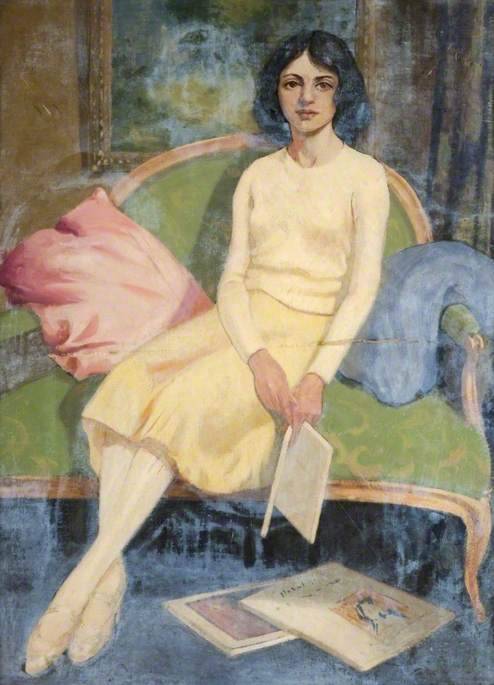
La jeunesse
George Telfer Bear (1876–1973)
Glasgow Museums Resource Centre (GMRC)
6 notes
·
View notes
Photo
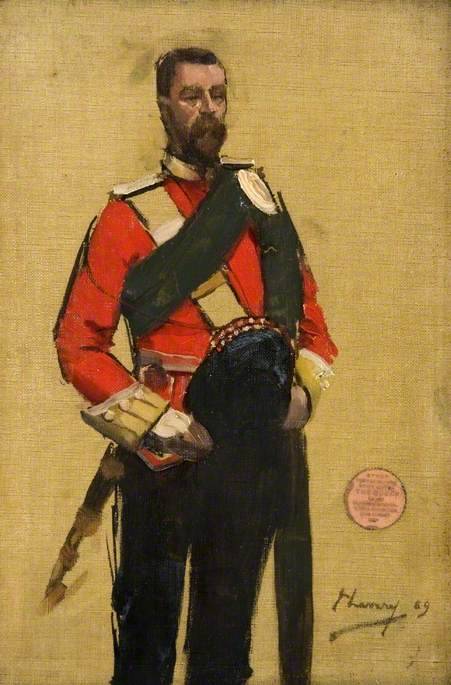
Captain Shaw, oil on canvas , 1889
John Lavery (1856–1941)
Glasgow Museums Resource Centre (GMRC)
#british#british army#victorian#scottish#highland#highlanders#history#military history#glasgow museums resource centre#gmrc
15 notes
·
View notes